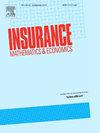在Yaari的二元理论中,排序风险更高
IF 2.2
2区 经济学
Q2 ECONOMICS
引用次数: 0
摘要
在Yaari(1987)风险下的双重选择理论中,风险偏好是基于一个包含主观扭曲函数的函数。在Wang(1996)溢价原则的背景下,Wang和Young(1998)为风险分布引入了一系列偏序类,这些偏序类描述了风险厌恶者群体基于该函数做出决策的偏好。在这个框架下,如果一个分布被认为比另一个分布风险小,则其均值小于或等于后者的均值,这可以使某些风险分布不可比较。在本文中,我们研究了基于TVaR曲线连续积分比较的风险分布的偏序序列,这些序列捕获了主要与超过其期望值的大风险有关的代理的偏好。通过双重风险规避的n度系数来探索这些阶数的规范性属性,该系数作为caball本文章由计算机程序翻译,如有差异,请以英文原文为准。
Ordering higher risks in Yaari's dual theory
In Yaari's (1987) dual theory of choice under risk, risk preferences are based on a functional that incorporates a subjective distortion function. In the context of Wang's (1996) premium principle, Wang and Young (1998) introduce a sequence of partial ordering classes for risk distributions which characterize the preferences of groups of risk-averse agents making decisions based on this functional. Under this framework, if one distribution is perceived as less risky than another, its mean is smaller than or equal to the latter's, which can make certain risk distributions non-comparable. In this paper, we investigate a sequence of partial orders for risk distributions, grounded in comparisons of successive integrals of TVaR curves, that capture the preferences of agents primarily concerned with large risks that exceed their expected values. The normative properties of these orders are explored through the nth-degree coefficient of dual risk aversion, which serves as the dual analog of the index of absolute risk aversion introduced by Caballé and Pomansky (1996) within the expected utility model.
求助全文
通过发布文献求助,成功后即可免费获取论文全文。
去求助
来源期刊

Insurance Mathematics & Economics
管理科学-数学跨学科应用
CiteScore
3.40
自引率
15.80%
发文量
90
审稿时长
17.3 weeks
期刊介绍:
Insurance: Mathematics and Economics publishes leading research spanning all fields of actuarial science research. It appears six times per year and is the largest journal in actuarial science research around the world.
Insurance: Mathematics and Economics is an international academic journal that aims to strengthen the communication between individuals and groups who develop and apply research results in actuarial science. The journal feels a particular obligation to facilitate closer cooperation between those who conduct research in insurance mathematics and quantitative insurance economics, and practicing actuaries who are interested in the implementation of the results. To this purpose, Insurance: Mathematics and Economics publishes high-quality articles of broad international interest, concerned with either the theory of insurance mathematics and quantitative insurance economics or the inventive application of it, including empirical or experimental results. Articles that combine several of these aspects are particularly considered.
 求助内容:
求助内容: 应助结果提醒方式:
应助结果提醒方式:


